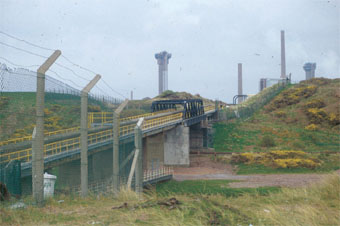
New Managing Director for Bellona Norway
The Board of the Bellona Foundation has appointed former Minister of Climate and the Environment Sveinung Rotevatn as Managing Director of Bellona No...
News

Publish date: January 21, 2003
Written by: Erik Martiniussen
News
In December last year the two British ministers where asking interested parties to consider whether it would be possible to impose a moratorium on the discharges of technetium-99 from the Sellafield site pending the introduction of chemical abatement technology using Tetraphenylphosphonium bromide (TPP).
The discharges continues
Bellona now argues that there is no sensible reason for delaying the moratorium decision. In response to the ministers Bellona writes it is implausible to think that a new study would add any material useful information to the already available.
Environmental Agency (EA) has done an extensive review of different ways to treat Tc-99. All their background material and their recommendations have been available since September 2001.
But the ministers want even more background material. In considering the possibility of a Tc-99 moratorium, they want EA to consider the possible options for the continued storage of Medium active concentrate (MAC) in a refurbished B211 facility, until a final abatement technology is chosen. B211 is the building where the historic backlogs of Tc-99 are stored. The building consists of ten tanks constructed as early as 1951, still containing 2000 cubic metres of MAC, and 200TBq of Tc-99. The tanks are licensed to 2006, but a refurbishment could lead to an extension of the license.
An-other possibility is to build a new storage tank. According to BNFL this would cost at least £ 100 million.
BNFL tired of waiting
While ministers are considering possible ways to implement the moratorium the discharges of Tc-99 are continuing, contamination the marine environment and neighbouring countries coastlines.
Bellona now argues that it is about time for the ministers to make up their mind, and leave it to the company involved and the regulators to find the best solution on the challenges imposed by such a moratorium.
And Bellona is not the only organisation that is tired of waiting for the British Government to decide. In response to Meacher and Becket the operator of the Sellafield site, British Nuclear Fuels Ltd (BNFL), also argues for a final decision: Information from the extensive recent reviews of Tc-99 options is already sufficient to asses the consequences, cost and benefits of such a moratorium, writes BNFL. But the company has a conclusion different to Bellona. BNFL argues that health, safety and environmental costs of such a moratorium are material, whereas the benefits are not material.
Norwegian business threatened
Before Christmas Bellona and the Confederation of Norwegian Industry (Bedriftsforbundet) sent a letter to BNFL. The two organisations are now considering if BNFL should be held liable for Norwegian enterprises financial losses related to depreciated commodity values and lost markets caused by pollution from Sellafield.
Norwegian aquaculture sell high-quality products of arctic quality harvested in the pure waters of the north. Some Norwegian enterprises now experience that unique raw materials no longer satisfy the quality demands established by the international market. Many Norwegian enterprises basing their activity on raw materials such as seaweed, sea tangle, lobsters and related organisms experience a loss of both national and international market share. Most likely, the value of these commodities will be further reduced if Sellafield continues to handle technetium-99 (Tc-99) with its current technology.
Tc-99 discharges from Sellafield has been going on since 1994, and has been met with massive international criticism. Tc-99 spreads relatively easily into the environment, and discharges from Sellafield take approximately 2,5 years to reach the Norwegian coast. Samples prepared by the Norwegian Radiation Protection Authorities (NRPA) in 2000 shows traces of Tc-99 as far away as Svalbard. The concentrations ranged from 0,1 7 Bq/m3. The highest levels were observed in the North Sea.
Bellona has previously documented a maximum concentration level of 33 Bq/kg Tc-99 (wet weight) in lobster caught off the southern coast of Norway in 2001. Furthermore, in 1998, the NRPA reported a maximum concentration of Tc-99 in lobster at 42 Bq/kg (Wet weight).
 Photo: Foto: Erik Martiniussen/ Bellona
Photo: Foto: Erik Martiniussen/ Bellona
TPP technology is the most developed for Tc-99 treatment. According to BNFL, all the laboratory-scale development work has been completed for this treatment. The next step is a plant-trail. The regulators are currently withholding permission for a TPP plant-trail because of concerns about the solid waste it will produce and its lack of compatibility with NIREX requirements. Regulators are also concerned about TPP toxicity levels.
Bellona s position is that ministers should make it possible for BNFL to conduct a plant-trail with TPP. Implementing an exception from the NIREX requirements for the small amount of waste resulting from a plant-trail can do this. A full review of the NIREX requirements may only be needed if the TPP process proves to be successful.
Bellona is well aware of the toxicity problems connected with TPP, and require that such a plant-trail have to be well supervised by the regulators. But without testing the technology the regulators wont even be able to figure out which abatement technology is most satisfactory to meet challenges imposed by a possible moratorium.

The Board of the Bellona Foundation has appointed former Minister of Climate and the Environment Sveinung Rotevatn as Managing Director of Bellona No...

Økokrim, Norway’s authority for investigating and prosecuting economic and environmental crime, has imposed a record fine on Equinor following a comp...

Our op-ed originally appeared in The Moscow Times. For more than three decades, Russia has been burdened with the remains of the Soviet ...

The United Nation’s COP30 global climate negotiations in Belém, Brazil ended this weekend with a watered-down resolution that failed to halt deforest...